Scaffolds for Critical Thinking Transcript
Speaker 1: Hi!
Children: Hi!
Speaker 1: Are your brains ready to go?
Children: Yes!
Speaker: Today I was in a fourth grade classroom, which was a gift because there are these enthusiastic kids who were so excited to learn and also a challenge because I spend nearly all of my time in a high school. It was really interesting for me to think about how to transfer this idea of teaching critical thinking to a fourth grade classroom, to ‘ really ‘ these emerging learners.
Alright friends, I’m going to tell you something. I have this box.
We have two simultaneous purposes going on in the classroom.
Children: Hi!
Speaker 1: We have adults in the classroom who are a part of this professional learning experience and then we also have the lesson that’s going on.
There were some things in it; there might be some clues to what we are supposed to learn.
The lesson today was on being able to get students to work from moving to the concrete to the abstract. In fourth grade terms, what that meant was that I wanted them to be able to see the difference between things in what we see in what we read, and then the ideas that they represent. As I designed this lesson and I really thought about what our younger, emerging critical thinkers need, I wanted to make sure that I created an environment that really privileged the disposition of curiosity.
Do you think you could help me out?
Children: Yes.
Speaker 1: That’s where the idea for this box came in.
So, I thought I should just take them out.
I would pull these different components of the lesson out of there, I think it created a natural umbrella of inquiry.
What do you think is going to happen?
I think it just kind of sets the tone for the culture or the environment that we want to have in which the teacher is releasing the responsibility of learning to the student.
This was one of the things that was in here. I don’t know, what do you think about those?
Speaker 2: I think it’s a type of beans.
Speaker 1: Does anybody else think that? Yeah? You thought it was a type of bean? I don’t know if it has anything to do with these, though, but there were these pictures that showed up in this box of mine. Should I give these to you too?
Children: Yeah.
Speaker 1: I don’t know.
Speaker 3: I know one of these, you have to put it in your teeth.
Speaker 4: Yeah, it makes your teeth straight.
Speaker 1: Okay, who has an idea? Yes, what do you think?
Speaker 5: We were saying that it might be to straighten out your teeth.
Speaker 1: Interesting. Should we write that down here? We’re going to see if we can add anything to our ideas about why these two things showed up on your desks.
Speaker 6: We can be taught how to eat healthy food?
Speaker 1: Okay, what do you think?
Speaker 7: Maybe we’re going to learn about how cause and effect, like if you eat these what is it going to do to the braces?
Speaker 1: That’s a really good question.
One of the things that happens when you’re kind of in this mode of inquiry is that you kind of leave some things dangling, really.
Speaker 8: [Wait, do you produce this?] its this something about like how it grows?
Speaker 1: Wow!
I knew that I would ask them to draw some conclusions about lima beans and braces and I knew that it wasn’t going to have this nice little bow tied around that understanding, and that was okay, but we needed some anchors for the lesson.
I think we should hang onto all of these really good idea. Can we leave these on your desk for a minute? You think that would be okay?
Children: Yes.
Speaker 1: Here’s this other thing: there are these words.
Next, we got into this concept attainment component where I put these “yes” examples and “no” examples of the difference between things and ideas.
Video games, Clash of Clans. Does anybody play Clash of Clans in here? Okay, here is the green example. Video games equals frustration. Do you get frustrated because you’re not getting to the next level?
Children: Yeah.
Speaker 1: You know, I could touch Clash of Clans. Couldn’t I point to it on the screen?
Children: Yeah.
Speaker 1: Can I touch frustration?
Children: No.
Speaker 1: Why not?
[crosstalk]
Speaker 9: Because it’s an idea.
Speaker 10: It’s a feeling.
Speaker 1: Because it’s a feeling, it’s something in your head.
It took us a while to work through those, but that was also really important and, again, really governed by questions.
Do you think you’re pretty good at this now?
Children: Yes.
Speaker 1: I think you are too, so this is what I’m going to do: I’m going to give you your own piece of blue, okay? Then I’m going to put one up on the board and I’m going to ask you to make a red and a green one for me. Can you do that?
Children: Yeah.
Speaker 1: Okay, here it is. Pet. If you were going to do one that was red you would do pet equals ‘ what would you write afterwards? Everybody do it on their blue piece of paper.
I was hoping that the one that I saved until the end about the pet would be the most relevant to them, which is why I saved it until the end because they actually had to finish the card.
Speaker 10: I have “fluffy.”
Speaker 1: Is that the name of a pet? No? Could it be the name of a pet?
Children: Yes.
Speaker 1: Okay, so if we’re going to do a green one for pet, it’s kind of tricky.
We are asking them to really practice a more difficult cognitive task, I think it’s really important to make the content more accessible or more relevant.
Before you write this down, what are you going to have to ask yourself? How does your pet ,
Speaker 11: How does your pet feel?
Speaker 1: Not how does your pet feel when you touch it, but how does it make you feel.
By creating this more inductive methodology, they were doing the transfer as they were figuring it out. I actually felt like even though it’s a slower process, it’s a more sure process.
Yes?
Speaker 12: Happy?
Speaker 1: Happy! Can we touch happy?
Children: No.
Speaker 1: No. Does it work? It does!
Once we practiced, then we took that and we wanted to apply it to a shared text.
Okay, this is called “A Bad Case of Stripes.” Camilla Cream loved lima beans but she never ate them. All of her friends hated lima beans and she wanted to fit in.
I chose to use that book because I wanted to find texts that really had a strong example of an object that represented an idea.
Why would she not eat the lima beans then?
Speaker 13: Because they would make fun of her.
Speaker 1: Oh, does that ever happen?
Children: Yes.
Speaker 1: “The next day was a disaster. ‘What are we going to do?’ cried Mrs. Cream, ‘It just keeps getting worse and worse!’ She began to sob.”
Speaker 14: Another thing they tell us, “Turn back into a normal kid!”
Speaker 1: What do you think about that word, “normal”? What is normal? Is there a normal?
Speaker 15: Like, to be yourself?
Speaker 1: Oh.
The lima beans in this book definitely represent an idea, and you don’t get it until the second to last page in the book.
“’Yes,’ said the old woman, ‘I knew the real you was in there somewhere.’ She patted Camilla on the head.” But even when we got to that second to last page, they had worked so hard that I as determined that I was not going to tell them what it meant.
If lima beans are over here, lima beans are what? Lima beans are…
Children: Ideas.
Speaker 1: Yes, what’s the idea?
Speaker 16: Someone who eats lima beans?
Speaker 1: To eat them…
Speaker 17: Some where there?
Speaker 1: Closer, I’m going to read it one more time. Listen. Okay? Listen for an idea, something you can’t touch.
I just kind of kept reading it, the same sentence maybe 3 or 4 times, because it was theirs. That was theirs to get, not mine to give.
“’Yes,’ said the old woman, ‘I knew the real you was in there somewhere.’” What?
Speaker 18: The real you?
Speaker 1: The real you! Do you think that’s what the lima bean are about?
Children: Yes!
Speaker 1: I think you’re right.
As soon as students are the ones who actually can offer those concepts, those ideas, we just know that they’ve got it.
Red or green?
Children: Red.
Speaker 1: Red, yes. And what’s the green?
Speaker 19: To be yourself.
Speaker 1: To be yourself. Is that an idea?
Children: Yes.
Speaker 1: So, once we did this kind of as a shared text, I wanted to move on to make it something a little more individual.
We’re going to look for what those braces mean.
I brought in an excerpt from a graphic novel called “Smile.”
“’That’s it,’ says the dentist, ‘braces work through subtle pressure.’”
There were these moments where the author starts talking about these braces.
Are there any words we can’t touch on this page?
Speaker 20: Power?
Speaker 1: Power, can you circle that word? Should I put power in green or red?
Children: Red. Green!
Speaker 1: We start to realize that this is something that’s very tangible, these braces, but they also seem to be talking about these ideas that go with them. I started to generate a list on the board.
Yeah.
Speaker 22: Problems?
Speaker 1: They’re problems.
Even that was helpful in reiterating this idea about the difference between concept and something tangible.
Have you ever decided you needed a break from a friend? Yeah? Did it ever feel like a little pressure?
One of the things that happens to me that I know that it happens to all kinds of teachers, is that you run out of time. Lo and behold, that’s exactly what happened today.
Okay, let’s do this: can you do this one thing for me?
I took 30 seconds maybe , a minute , and just asked them what do these braces tell us about friendship?
Speaker 23: Tight?
Speaker 1: They sometimes get tight?
I did give a little bit of wait time, just enough until I could see some of their eyes kind of clicking and they started to see how braces and friendship were connected to each other.
But in the end, sometimes you can do what?
Speaker 24: Smile?
Speaker 1: If I had finished “Smile,” the lesson would end with them doing some writing. With them trying to discern , on their own , how these braces connect to friendship as it is presented in this graphic novel.
You guys are wonderful!
I’m a high school teacher and so I don’t get into elementary classrooms that often so this was a really wonderful opportunity to think about how these skills go throughout the grade bands. Because sometimes we may think, “You can’t teach critical thinking to young kids” and I think those kids just showed that they’re just as ready as anyone else to do it.
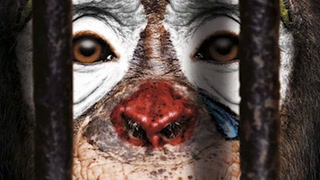

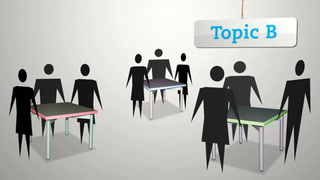

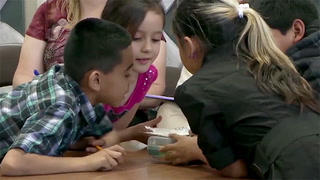
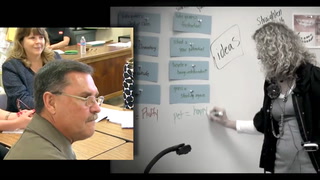
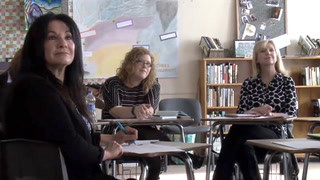









24 Comments
Emily Hein Oct 5, 2021 9:12am
The lesson on working on the concret to the obstract. This helped them develop concepts to meanings. This skill is challanging for young readers so I thought the box was a great idea to get the kids curious. It also made the classroom have more freedom by being able to guess what is in the box.
Kayla Middleton Oct 16, 2018 4:29pm
wei xiaohong May 28, 2018 7:48am
J Weldon Mar 30, 2018 2:26pm
Vanessa Mejia Mar 10, 2018 7:11pm